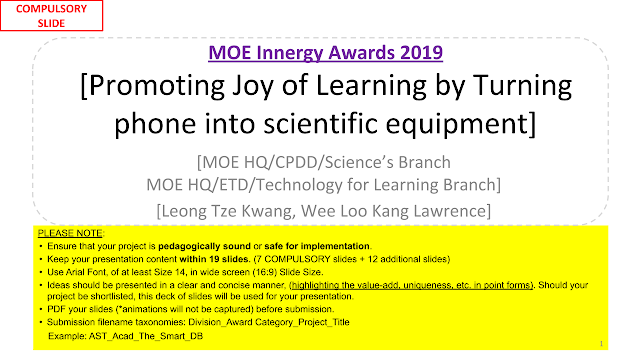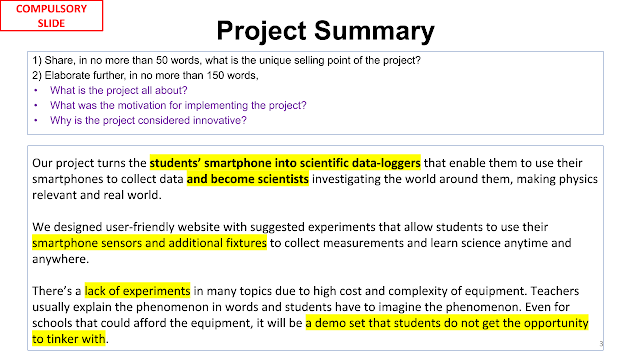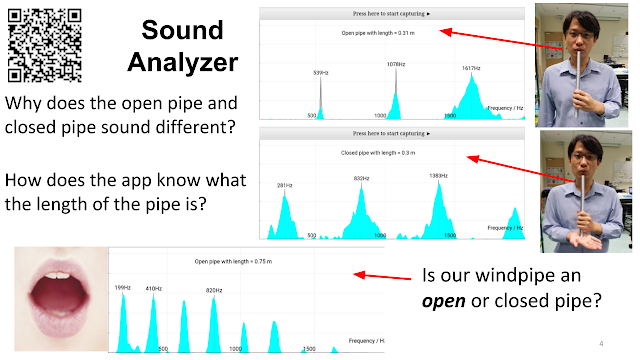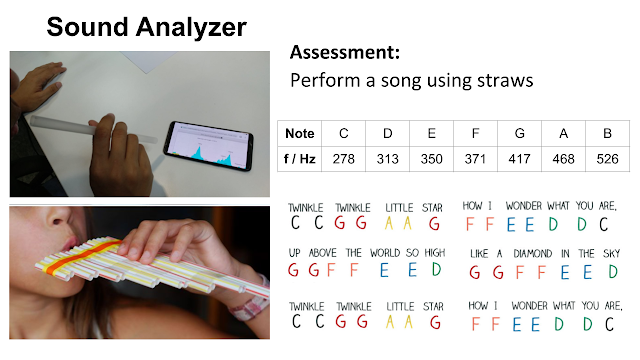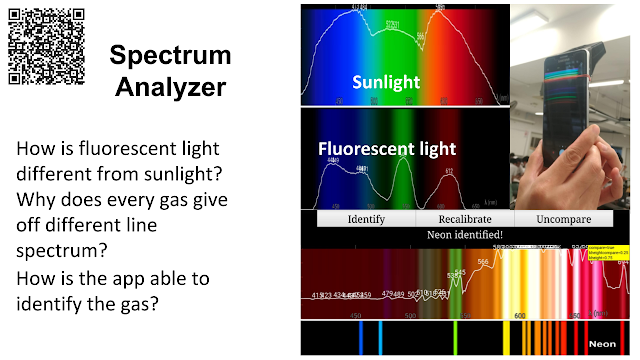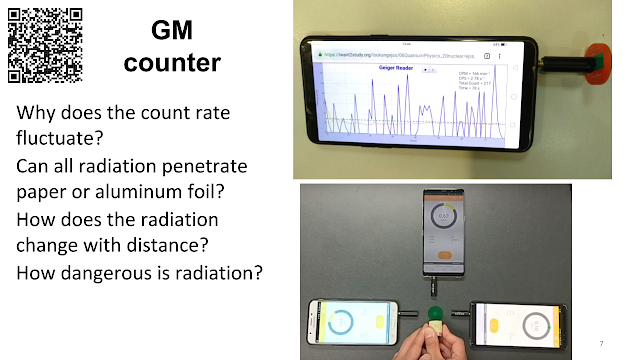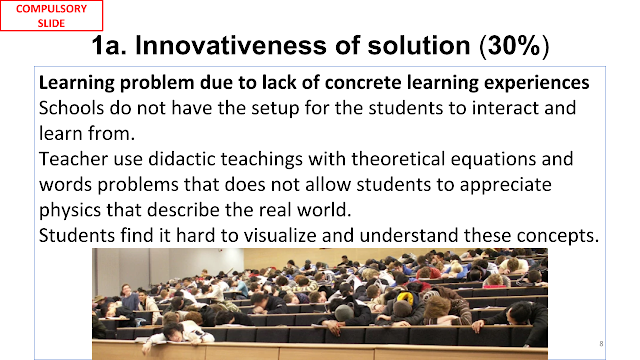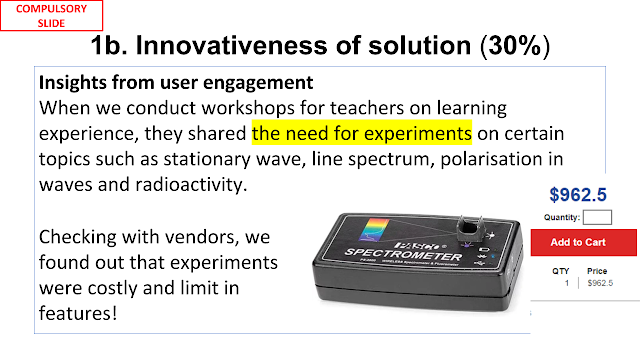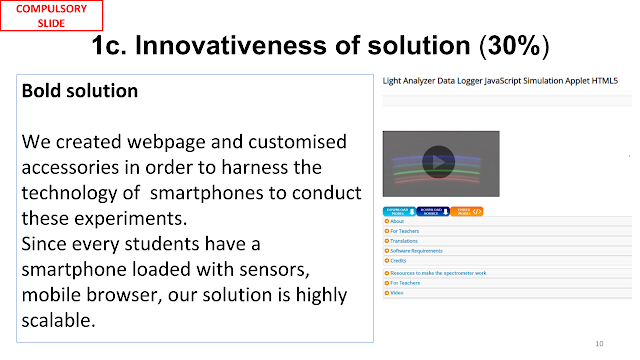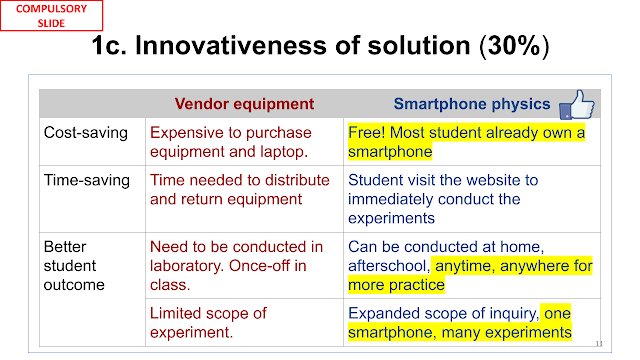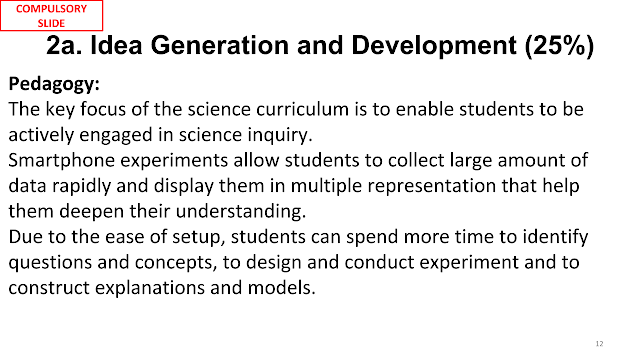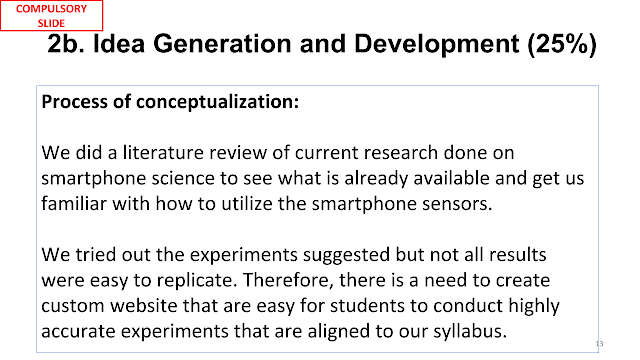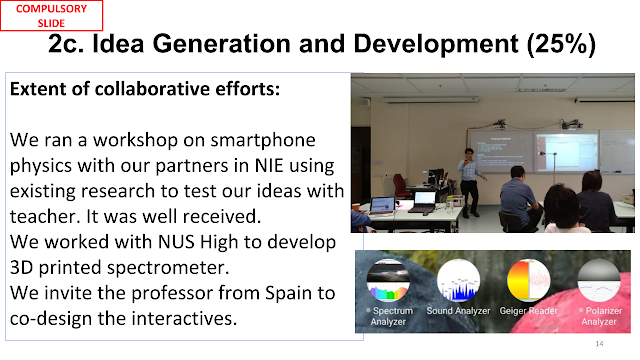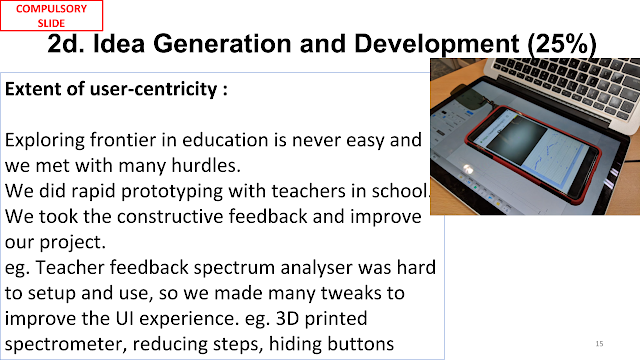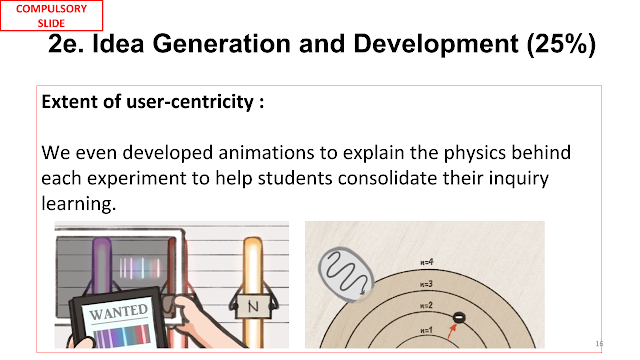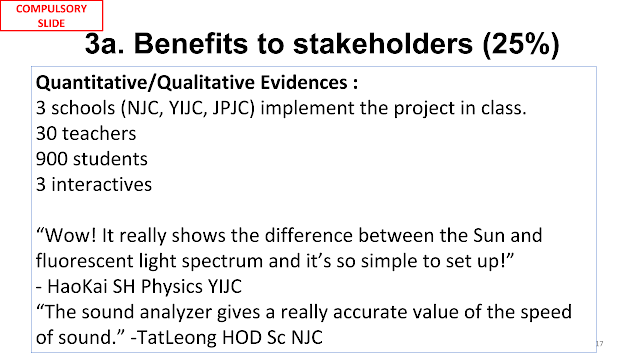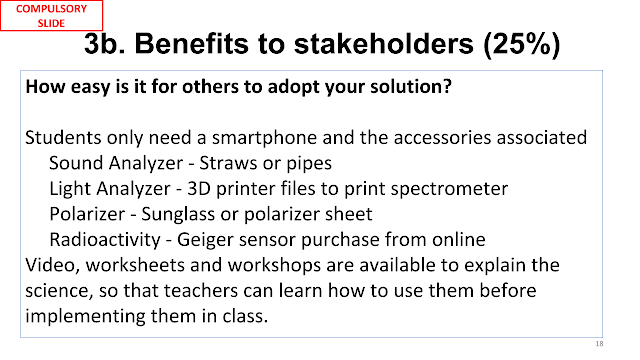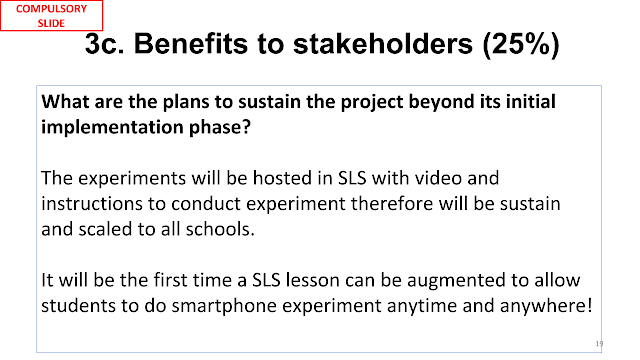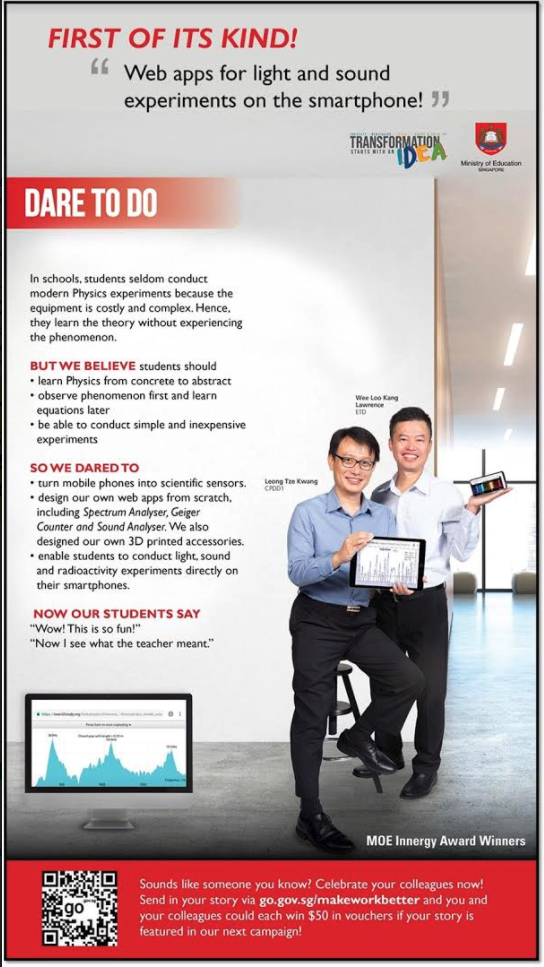Executive Summary:
This briefing document summarizes the key themes and important ideas presented in the "Gold Innergy Award 2019 Submission" by the Open Educational Resources / Open Source Physics @ Singapore team. The central theme is the innovative use of students' smartphones, coupled with web applications and low-cost 3D-printed accessories, to transform these ubiquitous devices into scientific data-loggers and tools for conducting physics experiments. This initiative addresses the challenges of costly and complex traditional scientific equipment, making hands-on science learning more accessible, engaging, and scalable. The submission highlights the development of various "apps" for analyzing sound, light, polarization, and radioactivity, alongside positive feedback and recognition from educators and the Ministry of Education (MOE) HQ staff.
Main Themes and Important Ideas:
- Addressing the Limitation of Traditional Science Equipment: The submission directly tackles the problem of expensive and complex scientific equipment hindering the frequency and scope of science experiments in schools. The team recognized that this lack of hands-on experience could negatively impact students' learning and engagement.
- "Conducting science experiments is not always easy – the equipment needed is often costly and complex, which means lack of experiments."
- "Teachers shared the need for experiments on certain science topics such as stationary wave, line spectrum, polarisation in waves and radioactivity. The equipment needed to observe these phenomena are costly and complex."
- Innovative Use of Smartphones as Scientific Tools: The core idea is to leverage the sensors already present in smartphones to collect scientific data. By developing web applications that interface with these sensors and designing simple accessories, the team enabled students to conduct experiments previously requiring specialized lab equipment.
- "To overcome this challenge, a team from CPPD and ETD decided to turn students’ smartphones into scientific data-loggers – enabling students to collect data, and investigate, just like a scientist."
- "The team designed web page and accessories, which use the sensors in the phone, to conduct experiments."
- "First of its kind to utilize mobile phone inputs and web-app, transforming the phone into scientific sensors. This allows lab experiments to be easily brought to the classrooms and offer a much cheaper alternative to scientific instruments."
- Development of Specific Web Applications and Accessories: The team developed concrete solutions for various physics topics, demonstrating the versatility of their approach.
- "The team developed apps for a sound analyser, light analyser, polarizer, radioactivity meter and their corresponding accessories."
- The submission provides direct links to prototypes for a Light Spectrometer, Sound Analyzer, Geiger Reader, and Polariser.
- Enhanced Accessibility and Scalability of Science Education: A key benefit of this innovation is its potential to reach a large number of students due to the widespread ownership of smartphones. It removes the constraints of traditional laboratories, allowing for learning "anytime, anywhere."
- "The solution is accurate and highly scalable since every student owns a smartphone, and can now engage in experiments without being constrained to laboratories."
- "Potential to scale this to other topics and beyond Singapore; team shared their solution at an international conference and were told it was a first in the education fraternity."
- "Highly innovative solution that allows students greater interaction with scientific phenomenon at a very low cost."
- Teacher Support and Integration into the Curriculum: The team recognized the importance of supporting teachers in adopting this new approach.
- "Video, worksheets and workshops were conducted to guide teachers on how to use them in class. These apps will be hosted in SLS with instructions on how to conduct the various experiments..." (SLS refers to the Student Learning Space, a national e-learning platform in Singapore).
- Positive Feedback and Recognition: The submission includes enthusiastic responses from teachers and MOE HQ staff, highlighting the impact and value of the innovation. These responses underscore various benefits, including:
- Increased Engagement and Joy of Learning: Many comments emphasize how the innovation makes learning "come alive," "fun," and "engaging" for students.
- "It makes teaching and learning come alive for students..."
- "Transforming the abstract into something concrete and fun to learn is not only innovative ..it is how learning suppose to be!"
- "It sparked the joy of learning in users!"
- Accessibility and Convenience: The use of readily available smartphones makes experiments easily accessible both inside and outside the classroom.
- "It allows learning on the go!"
- "The app is useful and taps on mobile devices which are readily available in almost every teachers' and students' pocket/bag. It is simply innovative as it makes life easier and encourages users to explore more beyond the classroom."
- "The web-based app sensors are easily accessible by students using their mobile phones anytime and anywhere. Convenient tools for students to support their learning and great pedagogical tools for teachers as well!"
- Empowering Inquiry and Exploration: The tools enable students to "create and explore on their own" and "collect real world data," fostering a more active and inquiry-based learning approach.
- "As a Science teacher, we are always looking for ways to create meaningful lessons for students to learn the concepts while being enjoyable. Using their OWN phones sensors to investigate everyday phenomenon allows students to create and explore on their own!"
- "An idea where students can do exploration on their own using mobile phone to collect real world data."
- Cost-Effectiveness and Resourcefulness: The use of smartphones as sensors offers a "much cheaper alternative to scientific instruments," particularly beneficial for schools with limited budgets.
- "The team uses cheap common materials to design and create simple yet creative and useful apparatus to support science teachers. I am impressed and grateful as our school does not have large funds to buy expensive equipment."
- "This has inspired me as it gives physics students a cheap & convenient way to do light & sound experiments wherever they are."
- Connecting Theory to Real-World Applications: The innovation helps students see the relevance of science concepts in their daily lives.
- "The team has thought about how Science concepts can be applied in authentic learning environment. Transforming a common device that is used daily into an innovation allows students to test out what they have learnt in real world scenarios. This is important in helping students to find connections with what is taught in the classroom"
- "The relevance of science application is so real and this makes learning authentic for student."
- Inspiration for Educators: The project has inspired other teachers to explore and create their own innovative resources.
- "As a physics teacher, I'm inspired by them to create resources customised for our students!"
- Open Educational Resources and Open Source Philosophy: The project operates under the principles of open education, making the resources potentially accessible to a wider audience beyond Singapore.
- The mention of "Open Educational Resources / Open Source Physics @ Singapore" in the title and the Creative Commons license at the end suggest a commitment to sharing and collaboration.
- "Their innovation not only enhances learning, but is also based on open source content. This makes it accessible to all educators interested in scaling the innovation."
Conclusion:
The "Gold Innergy Award 2019 Submission" effectively showcases a highly innovative and impactful approach to science education. By creatively utilizing the capabilities of smartphones and developing user-friendly web applications and accessories, the Open Educational Resources / Open Source Physics @ Singapore team has successfully addressed the limitations of traditional science equipment. This initiative not only makes science learning more accessible, affordable, and engaging for students but has also inspired educators and garnered significant positive recognition from the MOE. The project's foundation in open educational resources further amplifies its potential for widespread adoption and impact.
Study Guide: Turning Phones into Scientific Equipment
Quiz
- What was the primary challenge that the CPPD and ETD team aimed to address by turning smartphones into scientific equipment?
- Name three science topics for which the team developed web apps and accessories to utilize smartphone sensors.
- According to the text, what are two key benefits of using smartphones as scientific data-loggers in education?
- Besides the web apps, what other resources did the team create to support teachers in using this innovation?
- What was the significance of the international conference mentioned in the summary of the project?
- Give an example of how teachers and students have responded positively to this innovation, based on the "Thank you + Responses" section.
- How does this initiative align with the concept of "ubiquitous tech" in education, as mentioned in the responses?
- What potential impact does this innovation have on the cost and accessibility of science experiments for students?
- Name two specific web app prototypes mentioned in the text and the recommended browser for each (if specified).
- How does the use of smartphones as scientific equipment potentially shift the learning environment for science students?
Answer Key
- The primary challenge was that traditional science experiment equipment is often costly and complex, leading to a lack of hands-on experimentation opportunities for students.
- The team created web apps and accessories for stationary waves, line spectrum, polarization in waves, and radioactivity.
- Two key benefits are that it allows students to conduct experiments anywhere (not just in labs) since almost every student owns a smartphone, and it offers a much cheaper alternative to traditional scientific instruments.
- The team also developed videos, worksheets, and conducted workshops to guide teachers on how to integrate the smartphone science tools into their lessons.
- At the international conference, the team shared their solution and were told it was a first in the education fraternity, highlighting the novelty and potential impact of their work beyond Singapore.
- Many teachers expressed being impressed by how the innovation empowers students in their inquiry of the natural world and makes teaching and learning come alive by transforming abstract concepts into concrete and fun experiences.
- This initiative demonstrates how technology that is readily available and commonly used (ubiquitous tech like smartphones) can be meaningfully harnessed for educational purposes, expanding learning opportunities.
- This innovation significantly reduces the cost associated with science experiments and increases accessibility by utilizing a device that students already possess, removing the constraint of needing specialized and expensive lab equipment.
- The Light Spectrometer prototype recommends Chrome (except for iOS), and the Sound Analyzer and Geiger Reader prototypes recommend Safari on iOS and Chrome for other devices.
- The use of smartphones as scientific equipment allows for more interactive, hands-on learning experiences anytime and anywhere, potentially shifting the learning environment from the traditional laboratory to everyday settings and encouraging independent exploration.
Essay Format Questions
- Discuss the potential long-term impact of leveraging readily available technology like smartphones to enhance science education, considering both benefits and potential challenges.
- Analyze the innovative aspects of the "Open Educational Resources / Open Source Physics @ Singapore" project, explaining how it promotes a "joy of learning" in science.
- Evaluate the scalability and adaptability of the smartphone-as-scientific-equipment model in different educational contexts and across various science disciplines.
- Based on the provided testimonials, explain how this innovation has been perceived and adopted by educators, and what factors contribute to its positive reception.
- Explore the connection between making abstract scientific concepts more concrete and accessible through technology, and its potential to foster deeper understanding and engagement among students.
Glossary of Key Terms
- Open Educational Resources (OER): Educational materials and resources that are available freely for anyone to use, adapt, and share.
- Open Source Physics: A movement promoting the use and development of freely available physics resources, often including simulations and tools.
- Data-logger: An electronic device that automatically records measurements over time, allowing for the collection of scientific data.
- Web App: An application that runs on a web server and is accessed through a web browser, eliminating the need for installation on a device.
- 3D Printed Accessories: Physical components created using a 3D printer, designed to work in conjunction with the smartphone web apps for conducting experiments.
- SLS (Student Learning Space): Singapore's national online learning platform that provides educational resources and tools for students and teachers.
- Light Diffraction: The bending of light waves as they pass through an opening or around an obstacle, a phenomenon that can be studied using a light spectrometer.
- Sound Analyzer: A tool that can capture and analyze sound waves, allowing students to investigate properties of sound.
- Polarizer: A device that selectively transmits light waves vibrating in a particular direction, used to study the polarization of light.
- Radioactivity Meter (Geiger Reader): An instrument used to detect and measure ionizing radiation.
- Scalability: The ability of a solution or system to be expanded or adapted to serve a larger number of users or applications.
- Ubiquitous Tech: Technology that is present or available everywhere, such as smartphones in the context of this document.
- Experiential Learning: Learning that occurs through direct experience and active involvement in the learning process.
- Affordances of Technology: The potential uses or actions that a technology allows or enables.
- Pedagogical Tools: Resources and methods used by teachers to facilitate learning and instruction.
- TPCK (Technological Pedagogical Content Knowledge): A framework that describes the knowledge teachers need to effectively integrate technology into their teaching, encompassing technology, pedagogy, and content.
sharing the work of leongster for the benefit of MOrE.
Summary
v2
Conducting science experiments is not always easy – the equipment needed is often costly and complex, which means lack of experiments. To overcome this challenge, a team from CPPD and ETD decided to turn students’ smartphones into scientific data-loggers – enabling students to collect data, and investigate, just like a scientist. The team designed web page and accessories, which use the sensors in the phone, to conduct experiments. This idea to transform usage of mobile phones into scientific sensors especially the light diffraction web page app, is one of the best in the current education industry!
v1
Teachers shared the need for experiments on certain science topics such as stationary wave, line spectrum, polarisation in waves and radioactivity. The equipment needed to observe these phenomena are costly and complex. As such, the team created web apps and 3D printed accessories to utilize the sensors in our smartphones to conduct these experiments. The solution is accurate and highly scalable since every student owns a smartphone, and can now engage in experiments without being constrained to laboratories.
The team developed apps for a sound analyser, light analyser, polarizer, radioactivity meter and their corresponding accessories. Video, worksheets and workshops were conducted to guide teachers on how to use them in class. These apps will be hosted in SLS with instructions on how to conduct the various experiments, allowing students to do smartphone experiments anytime, anywhere.
• First of its kind to utilize mobile phone inputs and web-app, transforming the phone into scientific sensors. This allows lab experiments to be easily brought to the classrooms and offer a much cheaper alternative to scientific instruments.
• Potential to scale this to other topics and beyond Singapore; team shared their solution at an international conference and were told it was a first in the education fraternity.
• Highly innovative solution that allows students greater interaction with scientific phenomenon at a very low cost.
- Light Spectrometer prototype: (Direct Link) Need Chrome for all devices except iOS is not supported yet, Mac can but need to use Chrome.
- Sound Analyzer prototype: (Direct Link) Need Safari on iOS, the rest of other devices can use Chrome
- bonus app Geiger Reader prototype:(Direct Link) Need Safari on iOS, the rest of other devices can use Chrome
- https://sg.iwant2study.org/ospsg/index.php/interactive-resources/physics/06-quantum-physics/02-nuclear/819-geiger-reader
 buy suggested by teacher https://www.aliexpress.com/item/Newest-Geiger-Counter-Nuclear-Checker-to-detect-X-ray-Nuclear-Radiation-Gamma-Works-with-Smart-Phone/32297459661.html?spm=a2g0s.9042311.0.0.9WZ1j6
buy suggested by teacher https://www.aliexpress.com/item/Newest-Geiger-Counter-Nuclear-Checker-to-detect-X-ray-Nuclear-Radiation-Gamma-Works-with-Smart-Phone/32297459661.html?spm=a2g0s.9042311.0.0.9WZ1j6
- https://sg.iwant2study.org/ospsg/index.php/interactive-resources/physics/06-quantum-physics/02-nuclear/819-geiger-reader
- Polariser prototype: (Direct Link)
reference:
https://weelookang.blogspot.com/2019/07/innergy-award-2019-promoting-joy-of.html
Thank you + Responses from MOE HQ Staff on your team's Public Sector Transformation stories
https://weelookang.blogspot.com/2020/04/thank-you-responses-from-moe-hq-staff.html
- As a physics teacher, I attended their workshop and I am impressed by how their innovation can empower students in their inquiry of the natural world.
- Creative and innovative use of mobile phones to teach difficult scientific concepts in experiential way harnessing affordances of technology.
- It makes teaching and learning come alive for students, and shows how teachers can hack their own solutions
- The premise of their innovative idea is the most basic and yet effective
- It shows that ubiquitous tech can be meaningfully harnessed for education.
- Transforming the abstract into something concrete and fun to learn is not only innovative ..it is how learning suppose to be! Plus using a gadget or device that is easily accesible ! We are so proud that we have a Thinker and Innovator amongst us in ETD !
- It is interesting and can be done via the smartphone.
- It allows learning on the go!
- Exploring possibilities and pushing boundaries
- The team has thought about how Science concepts can be applied in authentic learning environment. Transforming a common device that is used daily into an innovation allows students to test out what they have learnt in real world scenarios. This is important in helping students to find connections with what is taught in the classroom
- The app is useful and taps on mobile devices which are readily available in almost every teachers' and students' pocket/bag. It is simply innovative as it makes life easier and encourages users to explore more beyond the classroom.
- We have been working on sustained commitment to computational physics education through creating and disseminating electronic books, simulations, and other tools to support computational thinking, and for research establishing the value of these tools and best practices for their use.
- As a Science teacher, we are always looking for ways to create meaningful lessons for students to learn the concepts while being enjoyable. Using their OWN phones sensors to investigate everyday phenomenon allows students to create and explore on their own!
- Students could use hp for learning physics
- students enjoy physics better.
- Everyone has a smart phone nowadays, but we didn’t know that it can be used in so many ways, especially in learning.
- Convenience of practical experiment brought to the modern tool of convenience. The ubiquitous handphone with a room to learn without repercussions!
- It's very important for students to be able to visualise abstract concepts which they are learning, and these apps made such learning so easily accessible to students. They can even use them outside school hours at home!
- An idea where students can do exploration on their own using mobile phone to collect real world data.
- Their passion, creativity, risk taking & ideology of teaching & learning
- The web-based app sensors are easily accessible by students using their mobile phones anytime and anywhere. Convenient tools for students to support their learning and great pedagogical tools for teachers as well!
- of the team's enthusiasm and passion in making learning accessible and fun for students. Their work has also inspired other teachers around the world to adopt the technology in their physics lessons.
- The team uses cheap common materials to design and create simple yet creative and useful apparatus to support science teachers. I am impressed and grateful as our school does not have large funds to buy expensive equipment.
- Lawrence has always been supportive of the needs of teachers. When I requested for a particular simulation which I wanted to show my students, he started designing in without hesitation. There were also times when I needed certain modifications, he did it within a day or 2. And when I told him more simulations should be converted to Html5 so that mobile devices can view them, he continued to work on them and expanded the library. I have been using his simulations and will continue to do so.
- I can learn Physics in such a fun and easy way, through the mobile devices and web app.
- Tools that can be used in and out of the classroom easily
- This has inspired me as it gives physics students a cheap & convenient way to do light & sound experiments wherever they are.
- We need more fun in our life, conveniently! Thanks.
- I love Physics, and tapping on technology to experience light/sound is an innovative and refreshing idea!
- It is fun and engaging.
- The innovation has brought learning to a whole new level of fun and engagement. It allows students to understand difficult Science concepts through the use of mobile phones which is easily accessible to them.
- An authentic learning experience not limited by resources not readily available
- It is innovative and ingenious to tap on everyday items such as smartphones to conduct experiments on the go! Our smartphone itself is a mini lab that is equipped with lots of peripherals and sensors that allow us to take in physical data and analyse it via suitable applications. I would definitely consider using the idea and incorporate it in my lessons to promote inquiry and inventive thinking.
- It sparked the joy of learning in users!
- It is very current and anyone can do it.
- He turned mobile devices into sensors... All of us can be scientists.
- The relevance of science application is so real and this makes learning authentic for student. Hope to see more of these applications for students to use.
- This story showcased the feasibility and ease of cross-division collaboration. Furthermore, i feel strongl for the officers' passion for students, although they are currently based in MOE HQ
- It’s convenient, and students get to benefit first hand.
- To be able to bring Physics concepts across to students, using daily available technology, is inspiring to both the educators and students.
- I teach Physics and I find the web apps are useful and easy to use to help bring this abstract topic into the concrete.
- Simple, innovative, cost savings, practical application
- When met with current constraints, the team didn't dismissed their thoughts for students to learn the physics theory through experiencing the phenomenon. Instead, they pushed on the idea and dared to explore ways to put forth their dreams to action. Hence making it possible for students to observe and learn through experiments and enabled the physics theory to come alive for the students.
- I am a Physics educator and it is useful to my students in their learning. It spurs me to explore other apps to use in teaching
- Creating moments of enlightenment is priceless, and accessible innovations that spark learning anytime, anywhere and by anybody ... that’s really inspiring!
- Making abstract concepts concrete and learnable is the core of every teacher's duty. Innovation should be like this - driven by users, for the users.
- Technology is harnessed with skills to make it possible for students to observe and experience the phenomenon. This will greatly motivate the learning of modern Physics and inspire the next generation to greater achievements. This is made possible without acquisition of expensive equipment. It opens up the horizon for much more learning in future.
- People often think of innovation as a spark, but it more like Edison's light bulb. After long hard work, the world realises it was needed all along.
- Learning is made fun!
- It proves how creative use of technologies could really enhance learning experience and make learning more efficient and effective.
- The team has made use of our quintessential mobile phones and turned it into a learning tool!
- Something new, convenient and transforms learning!
- Simple and fun with students in mind!
- This is the first of its kind in the world where students can conduct experiments without using highly expensive lab equipment. Other countries are adopting this innovation to make such hands on learning more accessible and affordable.
- Innovation is very apparent in the invention of web apps and use of handphones into scientific sensors
- I am amazed by how daily items can be enhanced to provide an elevated learning experience for students.
- Loo Kang and Tze Kwang have used what is available and familiar to the students to make something that is fun and can help them to learn. Practical applications make it seem that nothing is impossible. I am inspired by their resourcefulness and ability to see things from a different way to innovate.
- This is literally quality learning in the hands if every learner!
- Turning complex physics experiments to web apps are fun.
- Creators of the app exhibited strong TPCK and could tap on the affordance of various tools to develop learning opportunities for students on a gadget they carry everyday with them - smartphone.
- The visuals make learning difficult concepts so much easier to understand. Being able to see the different outcomes with different variables makes for concrete learning for students.
- Changing the mode of learning to create immediate relevance and retain interest.
- it makes theories come to life
- Lawrence and Tze Kwang have made learning Physics fun and all on the smartphone where our students spend most of their time on.
- Their innovation not only enhances learning, but is also based on open source content. This makes it accessible to all educators interested in scaling the innovation.
- Making an otherwise costly and complex experiment readily accessible to students.
- Taps on mobile devices to allow simulations and interactives!
- I could see how Everyday devices can be harnessed to teach and learn
- Students will be able to do simple and inexpensive experiments outside their classroom at their own pace safely.
- Even a simple device like mobile phone can be used as a sensor... really cool idea!!
- It makes me think of possibilities with new IT tools in transforming learning.
- Relevant for this tech generation
- Their innovate action make students feel & learnt the fun & joys of experiencing the phenomenon of physics.
- Students being able to learn repetitively and own time, Physics, onderve phenomenas, conduct simple n inexpensive via their hp. V useful during this CV19, home-based learning. It's cool!
- Innovators can share experiences w other educators.
- As a physics teacher, I'm inspired by them to create resources customised for our students!
- Students get to learn & have fun on Science experiments anytime & anywhere.
- I used to struggle with Physics and am glad that learning Physics has been made easier!
- It helps the whole educational community and students to learn and to innovate.
- The app is very helpful for students as it provides a form of virtual experiential learning for them to understand the concepts in the lessons.
- It has shown us how everyday devices like our smartphones can be utilised in ways we have not thought of , For use in teaching and learning
- They demonstrated how improbables can become probables and then reality.
- Use mobile apps is today`s trending.
- Inspire student learning is so important in their Education journey.
- Students can now use their mobile phones as a tool to explore science concepts!
- Both officers successfully translated their passion into reality and added value to students' learning.
- It captured the essence of making education come to life for the students. Students appreciate it when teachers show them the utility of what they study and gain a deeper appreciation for the subject matter.
- Gave inspiration about mobile learning. The potential of the teaching and learning applications using ubiquitous mobile phones will pave a new breed of ed innovations for our teachers.
- It is an easy to make and apply apparatus.
- When I was in secondary school, I found physics taught in a strange way. Most things we were taught were observable through feasible experiments, but we were instead given illustrated diagrams to learn from. This web app solves the problem in a practical way, without being overly taxing on school resources. Wish I had this app in school!
- Handphones can be used as sensors, what a wonderful idea.
- Handphones are extended as sensors too.
- As a science teacher, it is important for students to learn through the real-life phenomenon. I believe by using mobile phones as scientific sensors, it provides students an opportunity to learn through experience and collection of data. This allows students to behave like scientists!
- Bringing theories to live with the convenience of everyday devices and tech so that students can learn creatively and on the go. Awesome.

